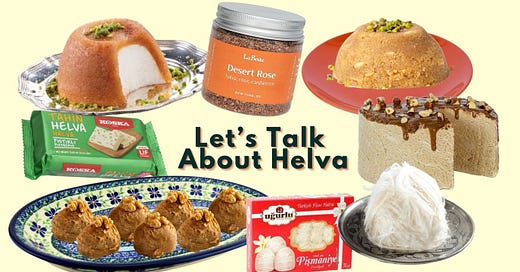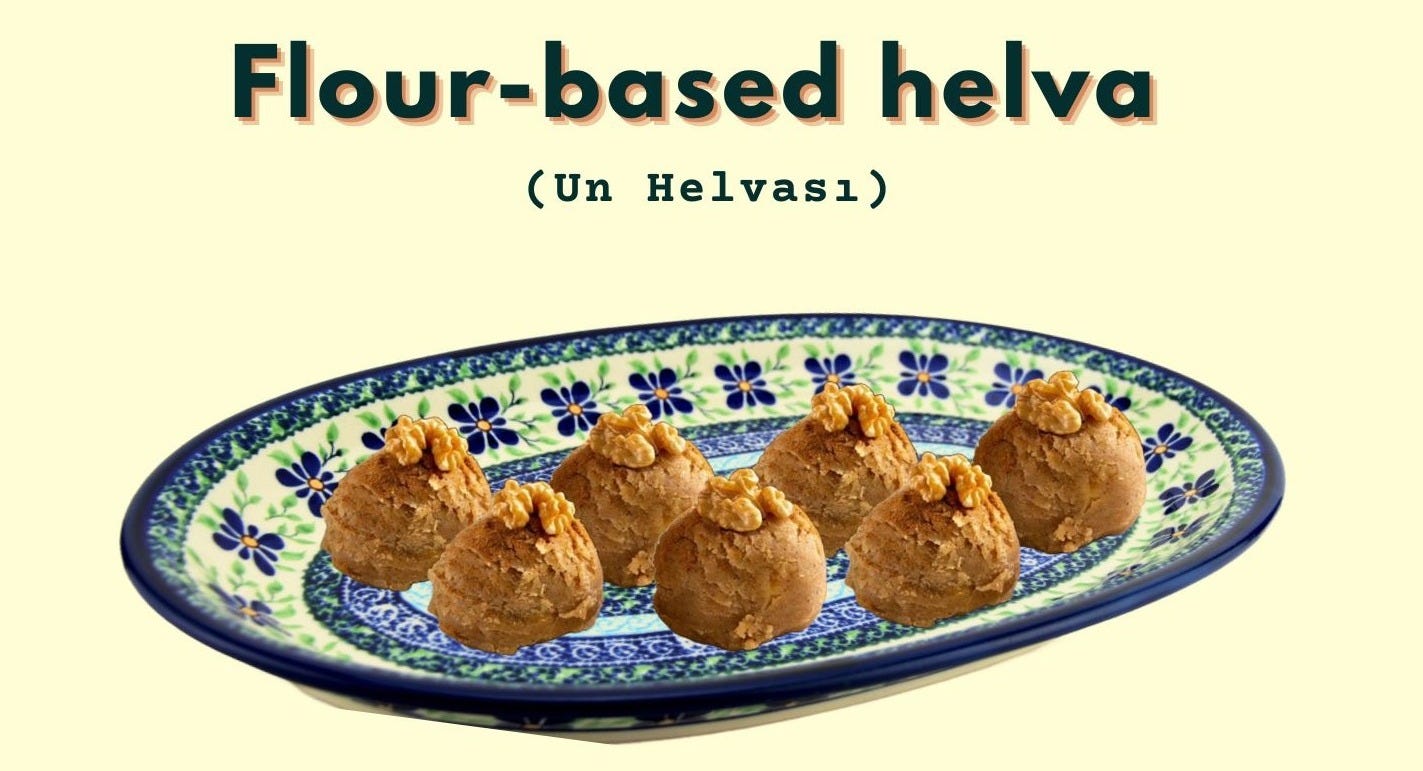Publication: March 2025, Issue #11
A couple of weeks ago, I shared a recipe for Sticky Date and Helva Puddings with Tahini Caramel (yes, they were as dreamy as they sound). In response, a handful of you reached out with pressing questions: “Wait… what exactly is helva and where do I find it?” First off, I love these kinds of questions, please keep them coming! If something is unfamiliar, I’m more than happy to take a deep dive. And second, buckle up, because once you discover helva, also known as halva, there’s no turning back.
Before we get into the specifics, let’s take a quick detour into its etymology. Derived from the Arabic ḥalwā (حلوى), meaning “sweet” or “sweet confection,” helva is proof that a few simple ingredients can create something amazing. Known as helva in Türkiye, it comes in several delicious forms. Like many Middle Eastern dishes, helva has evolved through regional influences, with each culture putting its own spin on it. While you can find versions from Iran to India, Israel to Lebanon, I’ll be focusing on how helva shines in Turkish cuisine.
According to Nevin Halıcı, author of Turkish Cook Book, helva is believed to be one of Türkiye’s oldest desserts with recipes dating back to the 11th century. Süleyman the Magnificent, the longest-reigning sultan of the Ottoman Empire (1520–1566, an impressive 46 years!), commissioned a dedicated kitchen next to his palace known as the Helvahâne, or "House of Helva." Here, dedicated cooks devoted their lives to perfecting and crafting helva, jams, jellies and other sugary confections.

In modern Türkiye, helva remains deeply significant, a staple at life’s most meaningful moments. It appears on tables during births, weddings and funerals, symbolizing both joy and sorrow. From religious ceremonies to feast days, one thing never changes: wherever people gather for life’s milestones, helva is there. Now, let’s explore four of the most common types of helva you may come across in Türkiye today.
1. Tahini-Based Helva (Tahin Helvası):
The most common type of helva in Türkiye is tahini helva, made from a simple trio: tahini (sesame paste), sugar and water. From there, it’s often customized with flavors like cocoa or mixed with nuts. This happens to be my mother-in-law’s favorite type of helva, almost turning into a post-dinner ritual. Usually sold in small bricks, she slices off a piece and serves it with Turkish tea. The moment it touches your tongue, the contrast is unforgettable: the slight crunch of sugar crystals, the nutty richness of sesame and the warmth of the tea gently melting the helva. In Türkiye, our go-to brand was Koska Tahini Helva with Pistachio and while homemade versions exist, most Turks opt for the convenience of store-bought.
In the U.S., I’ve heard rave reviews about Seed + Mill’s helva, which comes in a variety of flavors. Though I haven’t had the chance to try it myself, their offerings, which include a helva cake (pictured above in center) look enticing. This is the type of helva I crumbled into my Sticky Date and Helva Puddings with Tahini Caramel and it worked beautifully. You might also spot helva in more unexpected places, like as a garnish for ice cream or granola. A great example is La Boite’s helva blend (also pictured above, right), which combines helva, sesame seeds, rose petals and cardamom and can be used as a sprinkle of nutty, floral magic for desserts.
A recipe for Tahini-Based Helva can be found HERE.
2. Semolina-Based Helva (İrmik Helvası):
This type of helva is made from semolina, butter (or oil), milk and sugar, resulting in a warm and soft texture. I’ll never forget the time my husband’s cousin, a trained chef, made it for the family on a chilly night in Izmir. Slowly cooked over low-to-medium heat, the semolina transforms into something rich and toasty, perfect for cozy evenings.
When I lived in Beşiktaş, a neighborhood of İstanbul, food stalls served warm cups of semolina helva topped with Turkish ice cream. The contrast was divine. The hot, buttery helva melting into the cool, chewy ice cream (don’t worry, we’ll get to Türkiye’s famous stretchy ice cream another time) is unforgettable. Think warm brownie with vanilla ice cream, but with a uniquely Turkish twist.
A recipe for Semolina-Based Helva can be found HERE.
3. Flour-Based Helva (Un Helvası):
By now, you can probably guess that flour-based helva follows a simple formula: flour, butter, sugar and water. The process involves toasting a flour-and-butter roux until golden, then mixing it with a sugar syrup. While this version is time-intensive, the result is worth it. The finer flour creates a smoother, melt-in-your-mouth texture compared to the semolina variety.
My first time tasting un helvası was at Velvet Cafe, a charming spot near Galata Tower (the cafe has now relocated to Balat). Served warm, often sprinkled with cinnamon and pine nuts, it reminded me of a scoop of cookie dough. Paired with a bitter cup of Turkish coffee, it was nothing short of delightful.
A recipe for Flour-Based Helva can be found HERE.
4. Floss Helva (Pişmaniye):
Floss helva, also known as string helva, may have a simple ingredient list of flour, water and sugar but don’t be fooled. Mastering this sweet treat requires patience, skill and plenty of arm work. The process involves heating and combining the ingredients before repeatedly pulling the sugar through the toasted flour mixture, creating delicate, airy strands.
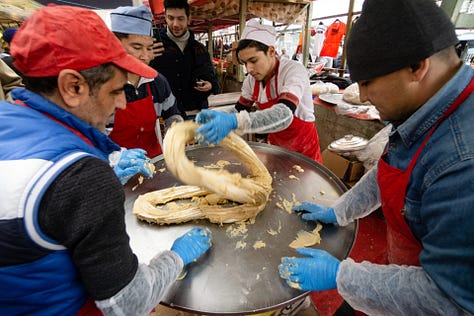
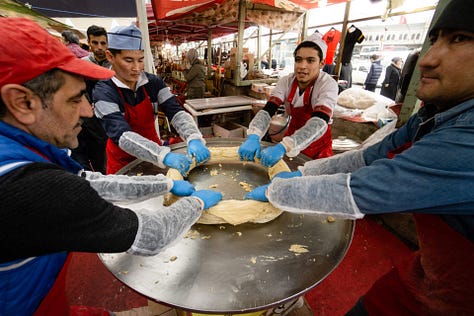
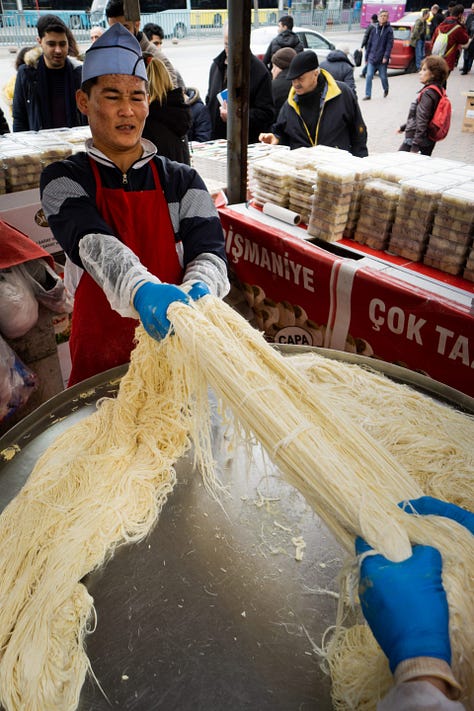
If you’re curious about pişmaniye, check out this post for a deep dive into its history, complete with behind-the-scenes photos of the production process. While often likened to cotton candy, pişmaniye has a richer, nuttier flavor and a denser texture. With its hair-like wisps, it’s perfect for decorating cakes or adding an unexpected texture to a dessert. I've only ever seen this available for purchase in Türkiye, but some bold home cooks dare to make it from scratch. Not me.
A recipe for Floss Helva (Pişmaniye) can be found HERE.
Though helva relies on just a few ingredients, its simplicity leaves little room for error, from toasting to syrup-making, it requires practice. The quality of ingredients also plays a role in achieving desired texture and flavor.
Beyond the classic varieties, there are many other types of helva, such as süt helvası (milk helva) and kağıt helvası (wafer helva). The varieties I’ve covered so far are among Türkiye’s most beloved, but I’ve barely scratched the surface of helva across the broader region. Just look at the photo above showing a market in Jerusalem showcasing over 20 different flavors! But for now, consider this Helva 101. If you’ve made it this far, congratulations, you’ve passed the class.


